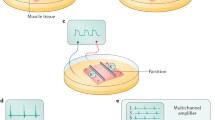Abstract
The recording of intestinal electrical activity is used to study digestive motility. This activity consists of slow waves occurring at a frequency of 13–20 cycles per minute. The slow waves are sometimes superimposed with spike potentials. Different patterns of distribution of spike potentials on the slow waves have been shown to occur in physiological and pathological conditions, so that longlasting recording sessions are increasingly required. This presents the problem of analysis of large amounts of data that has not yet been resolved satisfactorily. We present herein an analogue automated system of analysis of the intestinal electrical activityin dogs. This system works in real time and provides online data recorded on a graphic recorder. A microcomputer controlled printer and tape recorder were also used. Slow waves are characterised both by the amplitude and the timing of occurrence of relative minima. The spike bursts are detected on the slow waves; their distribution on the slow waves is given, and their energy is measured. Thus, our system allows an easy analysis of long duration chronic recordings, qualitatively (distribution of the spike bursts on the slow waves) as well as quantitatively (time of occurrence of slow waves and number and energy of the spike bursts).
Similar content being viewed by others
References
Alvarez, A. andMahoney, J. R. (1926) The myoelectric nature of the rythmic contractions of the intestine.Am. J. Physiol.,59, 421–432.
Bass, P., Code, C. F. andLambert, E. M. (1961) Motor and electric activity of the duodenum.Am. J. Physiol.,201, 287–291.
Bunker, C. E., Johnson, L. P. andNelsen, T. S. (1967) Chronic in situ studies of the electrical activity of the small intestine.Arch. Surg.,95, 259–268.
Code, C. F. andSchlegel, J. F. (1974) The gastrointestinal housekeeper. Motor correlates of the interdigestive myoelectric complex of the dog. Proceedings of the Fourth International Symposium on Gastrointestinal Motility, Vancouver, Mitchell Press Ltd. 631–634.
Crenner, F., Lambert, A., Schang, J. C., Angel, F. andGrenier, J. F. (1978) Chronic recording of intestinal Motility by multichannel telemetry. Proceedings of the Fourth International Symposium on Biotelemetry, Garmisch Partenkirchen Germany, 89–92.
Crenner, F., Lambert, A. Angel, F., Sava, P., Schang, J. C. andGrenier, J. F. (1979) Chronic multichannel telemetry of intestinal motility. Proceedings of the 14th Congress of the ESSR Barcelona.
Hiesinger, E. Hoernicke, H. andEhrlein, H. J. (1978) Computer analysis of electrical and mechanical activity of stomach, duodenum and caecum over long periods. InGastrointestinal motility in health and disease, Duthie, H. L. (Ed.)
Pousse, A., Mendel, C., Vial, J. L. andGrenier, J. F. (1978) Computer program for intestinal basic electrical rhythm patterns analysis.Pflügers Archiv.,376, 259–262.
Pousse, A., Mendel, C., Kachelhoffer, J. andGrenier, J. F. (1979) Computer program for intestinal spike bursts recognition.Pflügers Archiv.,381, 15–18.
Schang, J. C., Dauchel, J., Sava, P., Angel, F., Bouchet, P., Lambert, A. andGrenier, J. F. (1978) Specific effects of different food components on intestinal motility. Electromyographic study in dogs.Eur. Surg. Res.,10, 425–432.
Stoddard, C. J., Duthie, H. L., Smallwood, R. H. andLinkens, A. (1979) Colonic myoelectric activity in man: comparison of recording techniques and methods of analysis.Gut. 20, 476–483.
Szurszewski, J. H. (1969) A migrating electric complex of the canine small intestine.Am. J. Physiol.,217, 1757–1763.
Szurszewski, J. H., Elvebach, L. R. andCode C. F. (1970) Configuration and frequency gradient of electric slow-wave over canine small bowel.Am. J. Physiol.,218, 1468–1473.
Wingate, D., Barnett, T., Green, R. andArmstrong-James, M. (1977) Automated high-speed analysis of gastrointestinal Myoelectric activity.Am. J. Dig. Dis.,22, 243–251.
Wingate, D. andBarnett, T. (1978) The logical analysis of the electroenterogram.Am. J. Dig. Dis.,23, 553–558.
Wodlinger, H., Kunov, H. andAtwood, H. L. (1979) Electronic feature extractor for action potentials.Med. & Biol. Eng. & Comput.,17, 239–245.
Author information
Authors and Affiliations
Rights and permissions
About this article
Cite this article
Crenner, F., Lambert, A., Angel, F. et al. Analogue automated analysis of small intestinal electromyogram. Med. Biol. Eng. Comput. 20, 151–158 (1982). https://doi.org/10.1007/BF02441350
Received:
Accepted:
Issue Date:
DOI: https://doi.org/10.1007/BF02441350




